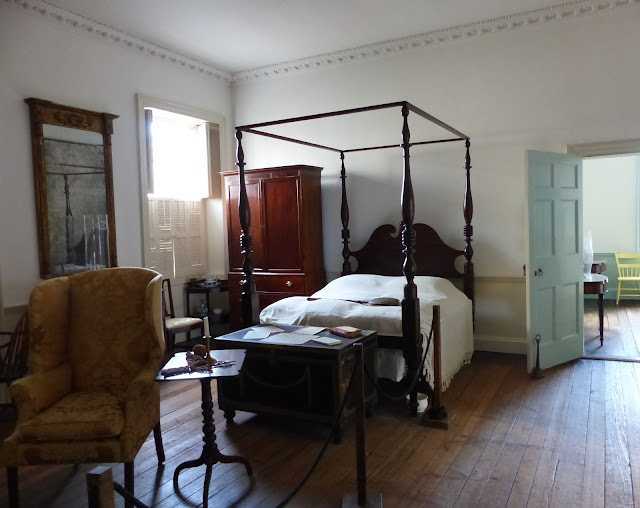Besides the art museum and the glass-making studio, the Chrysler museum complex also includes two historic homes. The homes, of course, stay in their respective historical buildings, which are both a short walk from the art museum.
The Moses Myers house in Norfolk is supposedly the oldest Jewish home in America open to the public as a museum. I don't know whether this statement is true, but so claims the pamphlet we got at the Chrysler Museum of Arts (also check out a cool 26-minute video about the house, produced by C-SPAN).
This is the house.
Once inside, we were the only visitors and had the undivided attention of Senior Gallery Host Karen Dutton, the very same one who starred in the C-Span show. We really enjoyed her tour.
Here I am holding the key to the Myers house - the only item in the house that you are allowed to touch.
Living room with family portraits: Moses Myers on the left, his wife Eliza on the right. These portraits are by Gilbert Stuart, who also painted the companion portraits of George Washington and his wife, hanging in the White House.
Moses and Eliza had 9 surviving children. The portrait in the middle is of their oldest son, John.
This is a detail from the mantelpiece in the previous photo. The gold-colored details are actually gold. They had been painted over, with white paint, at some point (probably around the time of Moses's bankruptcy) and were uncovered only recently.
This is the second son, Sam. He graduated from William and Mary in 1810 (the college’s first Jewish graduate), was a lawyer for a while (that's why the toga), then went to jail briefly for killing Richard Bowden, a man who insulted his father (beat his father publicly in the market square). Sam was later found not guilty (makes sense, in that day and age), married, and became a successful businessman and lawyer.
This is the third son, Myer. You can read about the whole family here.
Finally, Barton Myers, great-grandson of Moses and Norfolk’s leading visionary of the XXth century. Barton’s efforts molded Norfolk into the modern, prosperous port that it is today, by bringing two railroads to Norfolk.
Formal dining room.
This is the Myers tea urn, very similar to the Eventov tea urn, which gave Alex a chance to educate our gracious hostess on the fine points of making tea in a samovar, as well as distinctions between a samovar and a tea urn.
She found this information fascinating, all kidding aside, and we became good friends.
This is the music room. I forget who played the harp, probably one of the daughters. Or all of them?..
This is the master bedroom, on the second floor.
Attic, where all the youngest Myers children lived.
And this is where the kitchen used to be. This area is not restored and tourists are usually not allowed, but we got to see it because of the brownie points earned with the samovar explanations.
Exit from the kitchen into the garden.
On the way back, we saw some really ugly mermaids. (Actually, I noticed one previously near the USS Wisconsin, but failed to understand her significance and didn't take a picture). But after seeing them in droves, I realized that these mermaids seem to be the Norfolk mascots: like cows in NYC, cod in Boston, and pigs in Cincinnati. Here are a few.
Yet another one of the ugly mermaids, this one not so ugly, perched over the NorVa performing arts venue.
And here Alex is very happy, because there is a trolley coming. No, we do not need to take it. He just loves trolleys.
> Part 7


















No comments:
Post a Comment